In Situ Synthesis of Organic Polymer–Inorganic Nano ZnO Core–Shell Structured Sizing Agents and Their Effect on Carbon Fiber Interfaces and Composite Properties
Abstract
1. Introduction
2. Experiment
2.1. Material
2.2. Synthesis of Amine-Modified Epoxy Resin
2.3. Synthesis of the Intermediate of Isocyanate Containing Allyl Groups
2.4. Synthesis of Amine-Modified Epoxy Resin Containing Allyl Groups on Its Main Chain
2.5. Preparation of the Self-Emulsifying Cationic Polymer Emulsion of AEPA
2.6. In Situ Synthesis of the Self-Emulsifying Nano ZnO Particle-Modified Sizing Agent
2.7. In Situ Synthesis of Organic Polymer–Inorganic ZnO Core–Shell Sizing Agents
2.8. Preparation of Sized CF
2.9. Preparation of CF/EP Composites
2.10. Characterizations
3. Results and Discussion
3.1. Chemical Structure
3.2. Core–Shell Structure, Particle Size, and Storage Stability
3.3. Thermal Properties of Organic Polymer–Inorganic Nano ZnO Core–Shell Sizing Agents
3.4. Surface Morphology and Roughness
3.5. Contact Angle and Surface Energy of the Sized CF
3.6. Mechanical Properties of the Nanoparticles in the Organic Polymer–Inorganic Nano ZnO Core–Shell Sizing Agents
3.7. Mechanical Properties of CF/ER Composites
3.8. Fractured Morphology of CF/ER Composites
4. Conclusions
Supplementary Materials
Author Contributions
Funding
Data Availability Statement
Conflicts of Interest
References
- Zhang, J.; Lin, G.; Vaidya, U.; Wang, H. Past, present and future prospective of global carbon fibre composite developments and applications. Compos. Part B Eng. 2023, 250, 110463. [Google Scholar] [CrossRef]
- Barile, C.; Casavola, C. Mechanical characterization of carbon fiber reinforced plastics specimens for aerospace applications. Polym. Compos. 2018, 40, 716–722. [Google Scholar] [CrossRef]
- Czypionka, S.; Kienhöfer, F. Weight reduction of a carbon fibre composite wheel. Sci. Eng. Compos. Mater. 2019, 26, 338–346. [Google Scholar] [CrossRef]
- Song, P.; Fang, Q.; Liu, W.; Ma, X.; Li, Q.; Naik, M.-u.-d.; Ahmad, M.; Huang, G.; Yang, C. Effects of Sizing Agents and Resin-Formulated Matrices with Varying Stiffness–Toughness Ratios on the Properties of Carbon Fiber Epoxy Resin Composites. Polymers 2024, 16, 3447. [Google Scholar] [CrossRef]
- Lu, C.; Qiu, S.; Lu, X.; Wang, J.; Xiao, L.; Zheng, T.; Wang, X.; Zhang, D. Enhancing the Interfacial Strength of Carbon Fiber/Poly(ether ether ketone) Hybrid Composites by Plasma Treatments. Polymers 2019, 11, 753. [Google Scholar] [CrossRef]
- Wang, C.; Li, Y.; Tong, L.; Song, Q.; Li, K.; Li, J.; Peng, Q.; He, X.; Wang, R.; Jiao, W.; et al. The role of grafting force and surface wettability in interfacial enhancement of carbon nanotube/carbon fiber hierarchical composites. Carbon 2014, 69, 239–246. [Google Scholar] [CrossRef]
- Zhou, J.; Zhu, B.; Zhao, W.; Zhang, Y.; Li, J.; Fan, J.; Qiao, K. Enhancement of interfacial performance of carbon fiber reinforced polypropylene composites by dual action of polyetherimide nanoparticles and coatings. Colloids Surf. A Physicochem. Eng. Asp. 2024, 689, 133776. [Google Scholar] [CrossRef]
- Qiao, Y.; Jia, H.; Zhang, Y.; Zhao, W.; Zhang, E.; Zhang, S.; Jian, X.; Liu, C. Comprehensive evaluation of interfacial interactions optimization for CF reinforced high-performance thermoplastic composites by electrochemical deposition of conjugated polymers. Compos. Sci. Technol. 2024, 258, 110863. [Google Scholar] [CrossRef]
- Zhang, S.; Liu, W.B.; Hao, L.F.; Jiao, W.C.; Yang, F.; Wang, R.G. Preparation of carbon nanotube/carbon fiber hybrid fiber by combining electrophoretic deposition and sizing process for enhancing interfacial strength in carbon fiber composites. Compos. Sci. Technol. 2013, 88, 120–125. [Google Scholar] [CrossRef]
- Dai, Z.; Shi, F.; Zhang, B.; Li, M.; Zhang, Z. Effect of sizing on carbon fiber surface properties and fibers/epoxy interfacial adhesion. Appl. Surf. Sci. 2011, 257, 6980–6985. [Google Scholar] [CrossRef]
- Yuan, X.; Zhu, B.; Cai, X.; Liu, J.; Qiao, K.; Yu, J. Improved interfacial adhesion in carbon fiber/epoxy composites through a waterborne epoxy resin sizing agent. J. Appl. Polym. Sci. 2017, 134, 44757. [Google Scholar] [CrossRef]
- Fang, F.; Ran, S.; Fang, Z.; Song, P.; Wang, H. Improved flame resistance and thermo-mechanical properties of epoxy resin nanocomposites from functionalized graphene oxide via self-assembly in water. Compos. Part B Eng. 2019, 165, 406–416. [Google Scholar] [CrossRef]
- Kumar, S.; Lee, S.; Thomas, R.G.; Lee, S.J.; Lee, H.J.; Park, I.K.; Jeong, Y.Y.; Yoon, T.H.; Shin, D.C.; Lee, J.S. Self-emulsion polymerization of amphiphilic monomers—A green route to synthesis of polymeric nanoscaffolds. J. Polym. Sci. Part A Polym. Chem. 2019, 57, 1165–1172. [Google Scholar] [CrossRef]
- Liu, M.; Xu, M.; Zhou, J.; Zhang, G.; Ding, J.; Liu, P.; Yu, J.; Di, C.; Qiao, K. Interlaminar shear properties of carbon fiber/nylon 6 composites reinforced with GO-modified waterborne polyurethane sizing agent prepared by in situ polymerization. Prog. Org. Coat. 2025, 198, 108900. [Google Scholar] [CrossRef]
- Zhu, Y.; Liu, W.; Dai, H.; Zhang, F. Synthesis of a self-assembly amphiphilic sizing agent by RAFT polymerization for improving the interfacial compatibility of short glass fiber-reinforced polypropylene composites. Compos. Sci. Technol. 2022, 218, 109181. [Google Scholar] [CrossRef]
- Liu, W.; Zhu, Y.; Qian, C.; Dai, H.; Fu, Y.; Dong, Y. Interfacial modification between glass fiber and polypropylene using a novel waterborne amphiphilic sizing agent. Compos. Part B Eng. 2022, 241, 110029. [Google Scholar] [CrossRef]
- Yao, J.; Fang, Q.; Zhang, G.; Yang, C.; Niu, K. Effect of hydrophilic-hydrophobic ratio in self-emulsifying amphiphilic epoxy sizing agent on interfacial properties of carbon fibre/epoxy composites. Prog. Org. Coat. 2020, 143, 105621. [Google Scholar] [CrossRef]
- Zheng, Y.; Wang, X.; Wu, G. Facile Strategy of Improving Interfacial Strength of Silicone Resin Composites Through Self-Polymerized Polydopamine Followed via the Sol-Gel Growing of Silica Nanoparticles onto Carbon Fiber. Polymers 2019, 11, 1639. [Google Scholar] [CrossRef]
- Long, J.; Li, C.; Li, Y. Enhancement of Mechanical and Bond Properties of Epoxy Adhesives Modified by SiO2 Nanoparticles with Active Groups. Polymers 2022, 14, 2052. [Google Scholar] [CrossRef]
- Geng, Y.; Li, H.; Yao, J.; Niu, K.; Naik, M.-u.-d.; Ahmad, M.; Yang, C. Novel preparation of nano-SiO2 core-shell hybrid inorganic-organic sizing agents for enhanced interfacial and mechanical properties of carbon fibers/epoxy composites. Compos. Struct. 2023, 319, 117086. [Google Scholar] [CrossRef]
- Attia, M.; McMahon, N.; Li, H.; Lin, R.B.; DeLuna, F.; Shi, Y.; Chen, B.; Ye, J.Y. Novel route to size-controlled synthesis of MnFe2O4@MOF core-shell nanoparticles. J. Solid State Chem. 2020, 283, 121127. [Google Scholar] [CrossRef] [PubMed]
- Cheng, C.; Zhang, M.; Wang, S.; Li, Y.; Feng, H.; Bu, D.; Xu, Z.; Liu, Y.; Jin, L.; Xiao, L.; et al. Improving interfacial properties and thermal conductivity of carbon fiber/epoxy composites via the solvent-free GO@Fe3O4 nanofluid modified water-based sizing agent. Compos. Sci. Technol. 2021, 209, 108788. [Google Scholar] [CrossRef]
- Kuttner, C.; Hanisch, A.; Schmalz, H.; Eder, M.; Schlaad, H.; Burgert, I.; Fery, A. Influence of the polymeric interphase design on the interfacial properties of (fiber-reinforced) composites. ACS Appl. Mater. Interfaces 2013, 5, 2469–2478. [Google Scholar] [CrossRef] [PubMed]
- Cheng, X.; Huang, Y.; Fang, Q.; Gao, J.; Luo, T.; Zhou, Y.; Yang, C. Effect of the double bond content of sizing agents on the mechanical properties of carbon fibre reinforced vinyl ester composites. Compos. Sci. Technol. 2022, 218, 109145. [Google Scholar] [CrossRef]
- Janssen, D.; De Palma, R.; Verlaak, S.; Heremans, P.; Dehaen, W. Static solvent contact angle measurements, surface free energy and wettability determination of various self-assembled monolayers on silicon dioxide. Thin Solid Film. 2006, 515, 1433–1438. [Google Scholar] [CrossRef]
- Fang, Q.; Yao, J.; Niu, K.; Tang, J.; Wei, Y.; Guo, Q.; Yang, C. Effect of Molecular Weight of Self-Emulsifying Amphiphilic Epoxy Sizing Emulsions on the Carbon Fibres and Interfacial Properties of Their Composites. Polymers 2020, 12, 2439. [Google Scholar] [CrossRef]
- Cheng, X.; Han, Q.; Yue, B.; Shi, M.; Yang, C. Self-assembled nano-polymers modified water-based sizing agent for enhancing the dual interfacial properties of carbon fibre/epoxy resin composites. Compos. Part B Eng. 2023, 262, 110828. [Google Scholar] [CrossRef]
- Bakhshandeh, E.; Bastani, S.; Saeb, M.R.; Croutxé-Barghorn, C.; Allonas, X. High-performance water-based UV-curable soft systems with variable chain architecture for advanced coating applications. Prog. Org. Coat. 2019, 130, 99–113. [Google Scholar] [CrossRef]
- Gu, J.; Lv, Z.; Wu, Y.; Guo, Y.; Tian, L.; Qiu, H.; Li, W.; Zhang, Q. Dielectric thermally conductive boron nitride/polyimide composites with outstanding thermal stabilities via in -situ polymerization-electrospinning-hot press method. Compos. Part A Appl. Sci. Manuf. 2017, 94, 209–216. [Google Scholar] [CrossRef]
- Zhang, S.; Yu, A.; Liu, S.; Zhao, J.; Jiang, J.; Liu, X. Effect of silica nanoparticles on structure and properties of waterborne UV-curable polyurethane nanocomposites. Polym. Bull. 2011, 68, 1469–1482. [Google Scholar] [CrossRef]
- Yan, T.; Yan, F.; Li, S.; Li, M.; Liu, Y.; Zhang, M.; Jin, L.; Shang, L.; Liu, L.; Ao, Y. Interfacial enhancement of CF/PEEK composites by modifying water-based PEEK-NH2 sizing agent. Compos. Part B Eng. 2020, 199, 108258. [Google Scholar] [CrossRef]
- Zhang, T.; Zhao, Y.; Li, H.; Zhang, B. Effect of polyurethane sizing on carbon fibers surface and interfacial adhesion of fiber/polyamide 6 composites. J. Appl. Polym. Sci. 2018, 135, 46111. [Google Scholar] [CrossRef]
- Zhao, Z.; Wang, X.; Jing, X.; Zhao, Y.; Lan, K.; Zhang, W.; Duan, L.; Guo, D.; Wang, C.; Peng, L.; et al. General Synthesis of Ultrafine Monodispersed Hybrid Nanoparticles from Highly Stable Monomicelles. Adv. Mater. 2021, 33, e2100820. [Google Scholar] [CrossRef]
- Wang, C.; Wu, Y.; Fang, Y. A Novel Topography and Elasticity Synchronous Measure Approach With an AFM. IEEE Trans. Instrum. Meas. 2020, 69, 8401–8410. [Google Scholar] [CrossRef]
- Widom, B. Capillarity and Wetting Phenomena: Drops, Bubbles, Pearls, Waves. Phys. Today 2004, 57, 66–67. [Google Scholar] [CrossRef]
- Hu, J.; Yan, F.; Liu, H.; Zhao, L.; Li, Z.; Liu, Y.; Ao, Y.; Liu, L. Water-based PEKC-COOH sizing agent for enhancing the interfacial adhesion of carbon fiber/polyether-ether-ketone composites. Compos. Part B Eng. 2021, 225, 109279. [Google Scholar] [CrossRef]
- Song, W.; Gu, A.; Liang, G.; Yuan, L. Effect of the surface roughness on interfacial properties of carbon fibers reinforced epoxy resin composites. Appl. Surf. Sci. 2011, 257, 4069–4074. [Google Scholar] [CrossRef]
- Lei, K.; Qin, W.; Bai, S.; Cao, J.; Chen, L. Water-based PES-NaPSS sizing agent without surfactant for interface enhancement of CF/PEEK composites. Compos. Sci. Technol. 2024, 258, 110892. [Google Scholar] [CrossRef]

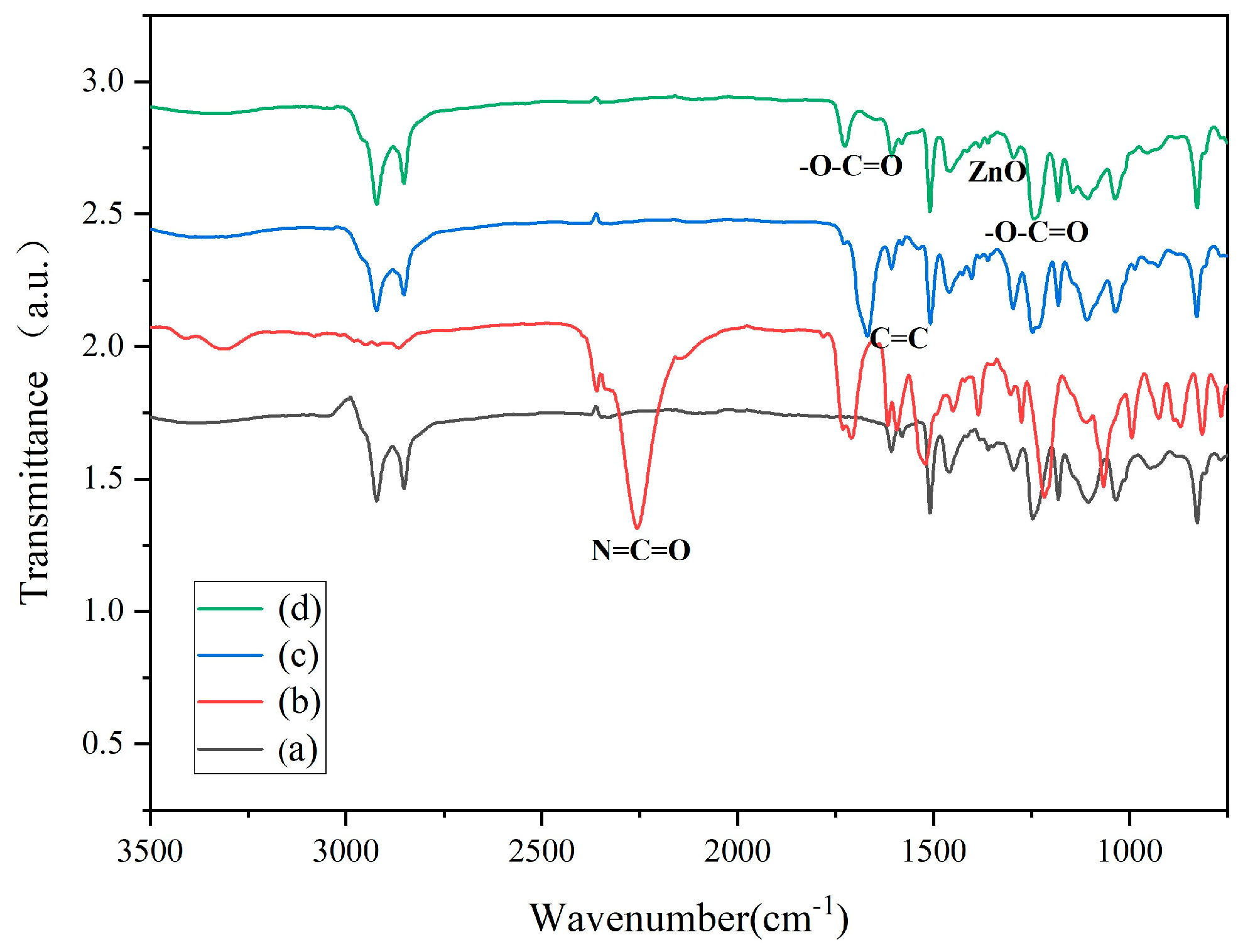


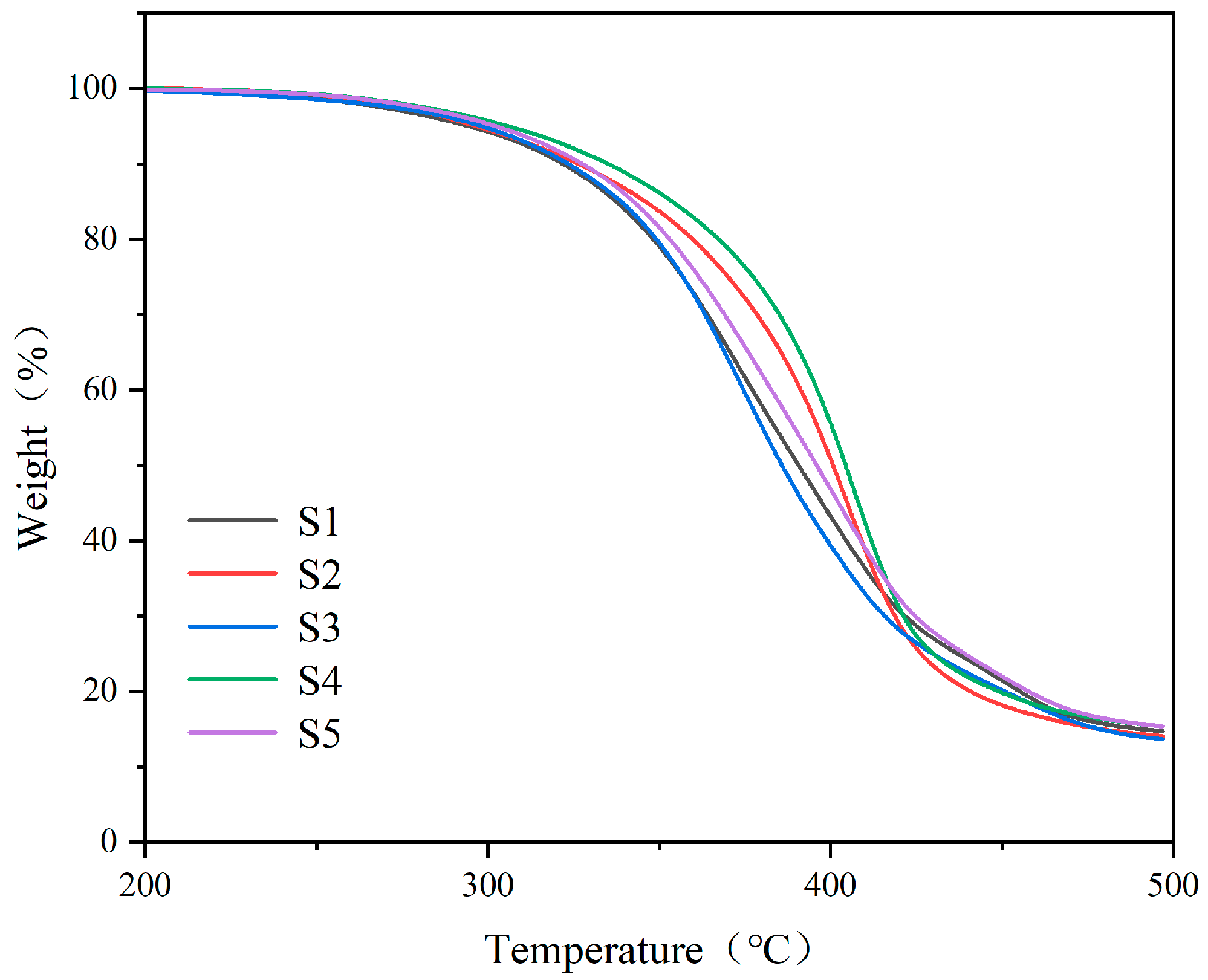
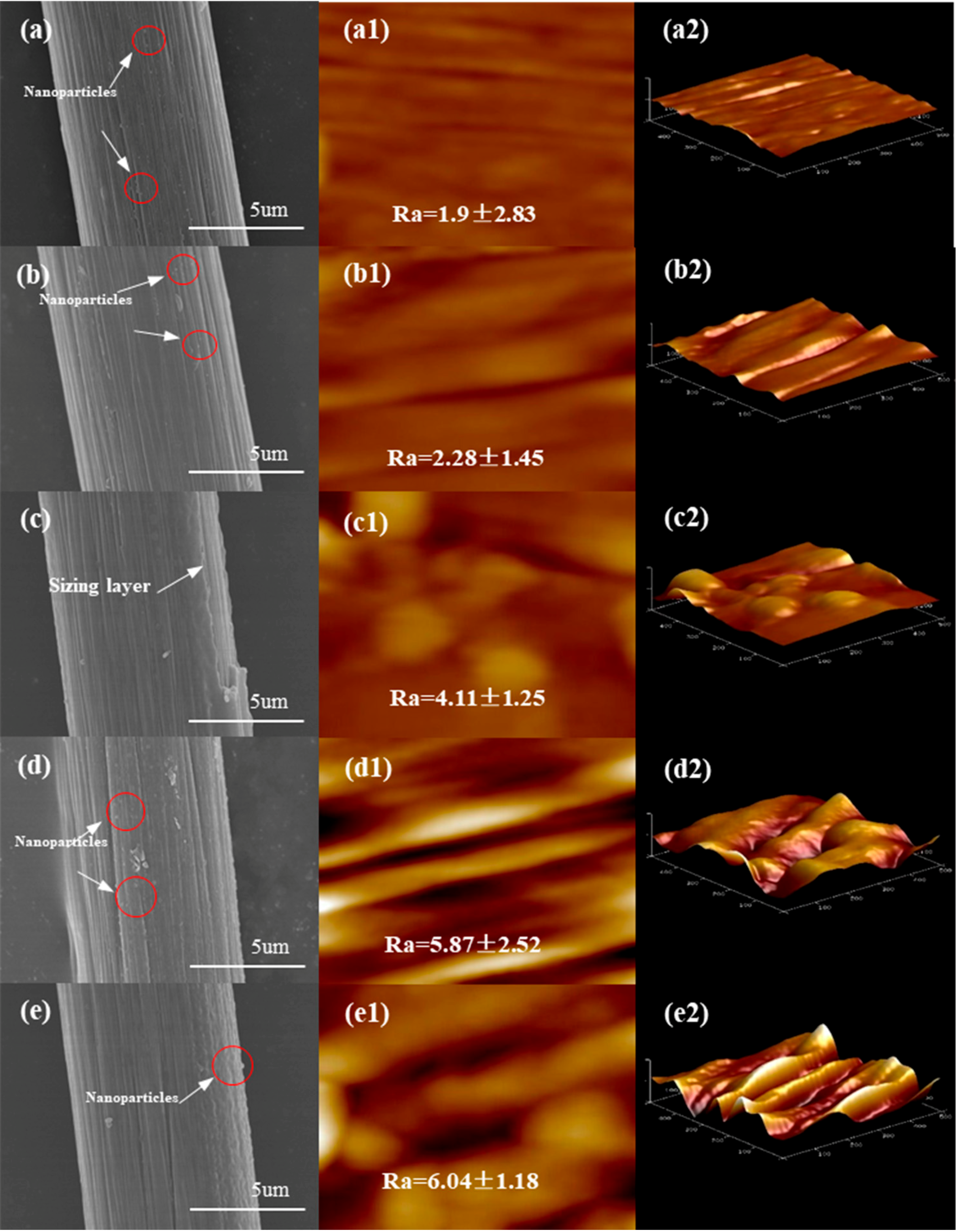

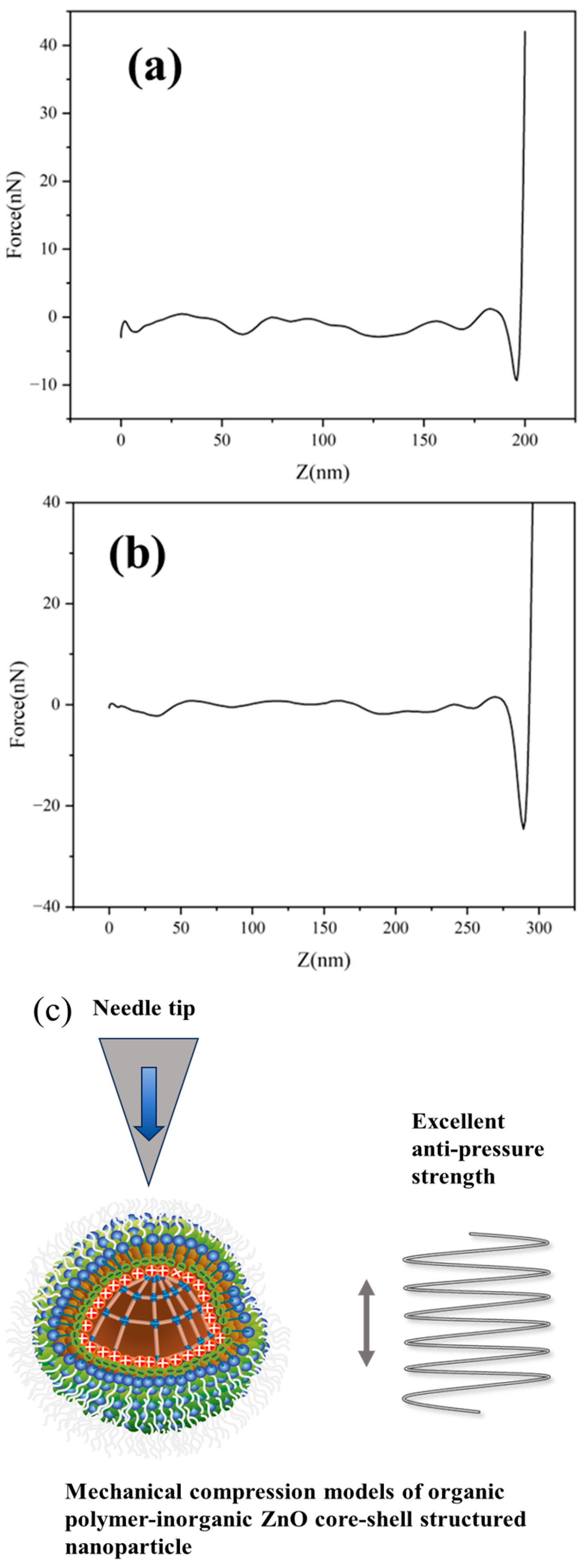
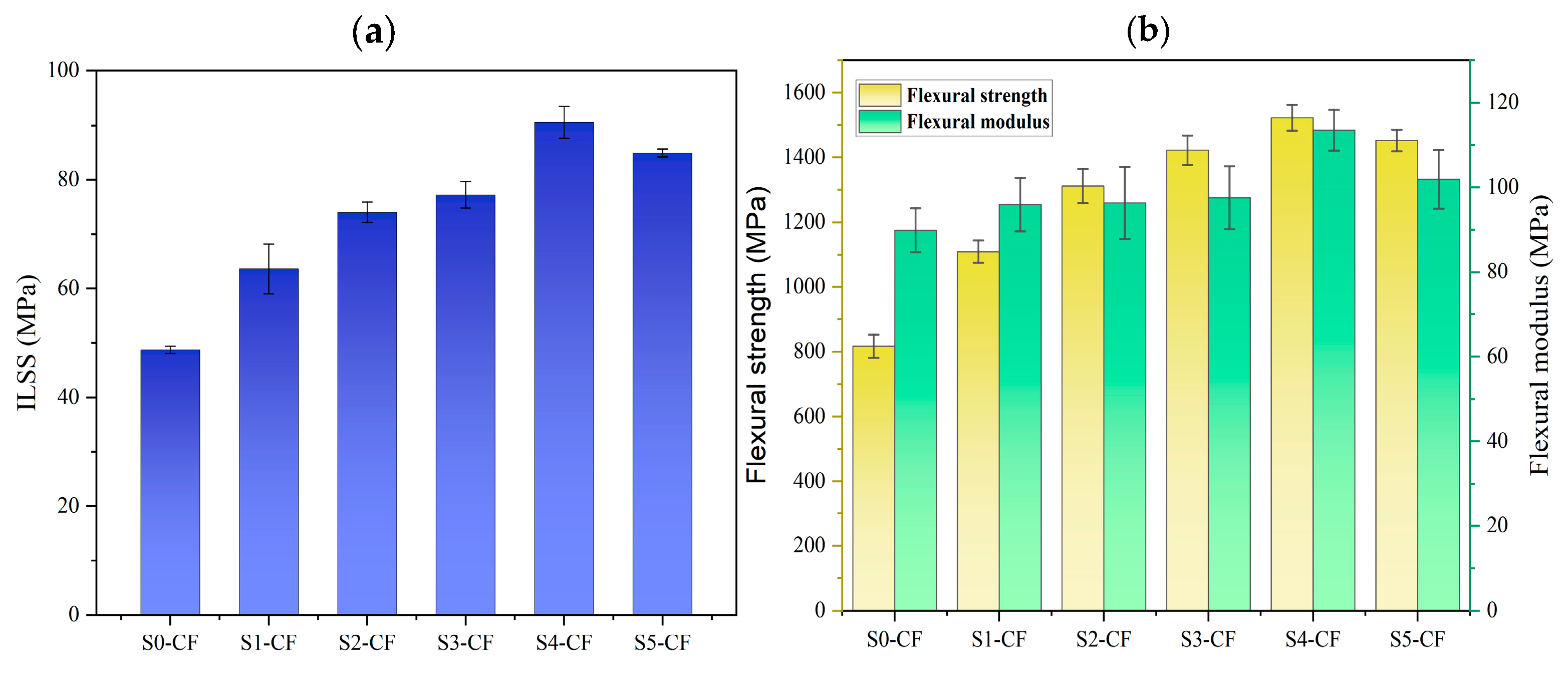

| Sizing Agents | Quantities of Reactants (g) | ||
|---|---|---|---|
| AEPA | ZAA | MMA | |
| S0 | 50.21 | 6.33 | 0 |
| S1 | 50.33 | 6.34 | 9.79 |
| S2 | 50.19 | 6.32 | 13.02 |
| S3 | 50.14 | 6.32 | 15.60 |
| S4 | 50.25 | 6.33 | 19.55 |
| S5 | 50.29 | 6.34 | 23.48 |
| Sizing Agents | Characteristic Thermal Data (°C) | ||
|---|---|---|---|
| T5 | T30 | THeat resistance index | |
| S1 | 294 | 364 | 165 ± 1.57 |
| S2 | 297 | 379 | 170 ± 1.86 |
| S3 | 298 | 363 | 165 ± 1.49 |
| S4 | 306 | 385 | 173 ± 1.55 |
| S5 | 302 | 369 | 168 ± 1.62 |
| Sizing Agent | DTM Modulus (Gpa) |
|---|---|
| S0 | 1.04 ± 0.16 |
| S1 | 4.84 ± 0.22 |
| S2 | 5.31 ± 0.26 |
| S3 | 5.54 ± 0.12 |
| S4 | 6.17 ± 0.15 |
| S5 | 5.78 ± 0.18 |
Disclaimer/Publisher’s Note: The statements, opinions and data contained in all publications are solely those of the individual author(s) and contributor(s) and not of MDPI and/or the editor(s). MDPI and/or the editor(s) disclaim responsibility for any injury to people or property resulting from any ideas, methods, instructions or products referred to in the content. |
© 2025 by the authors. Licensee MDPI, Basel, Switzerland. This article is an open access article distributed under the terms and conditions of the Creative Commons Attribution (CC BY) license (https://creativecommons.org/licenses/by/4.0/).
Share and Cite
Liu, W.; Ahmad, M.; Song, P.; Fang, Q.; Li, Q.; Huang, G.; Yang, C. In Situ Synthesis of Organic Polymer–Inorganic Nano ZnO Core–Shell Structured Sizing Agents and Their Effect on Carbon Fiber Interfaces and Composite Properties. Polymers 2025, 17, 773. https://doi.org/10.3390/polym17060773
Liu W, Ahmad M, Song P, Fang Q, Li Q, Huang G, Yang C. In Situ Synthesis of Organic Polymer–Inorganic Nano ZnO Core–Shell Structured Sizing Agents and Their Effect on Carbon Fiber Interfaces and Composite Properties. Polymers. 2025; 17(6):773. https://doi.org/10.3390/polym17060773
Chicago/Turabian StyleLiu, Wen, Mudasir Ahmad, Pengfei Song, Qianli Fang, Qingchao Li, Guoqing Huang, and Chuncai Yang. 2025. "In Situ Synthesis of Organic Polymer–Inorganic Nano ZnO Core–Shell Structured Sizing Agents and Their Effect on Carbon Fiber Interfaces and Composite Properties" Polymers 17, no. 6: 773. https://doi.org/10.3390/polym17060773
APA StyleLiu, W., Ahmad, M., Song, P., Fang, Q., Li, Q., Huang, G., & Yang, C. (2025). In Situ Synthesis of Organic Polymer–Inorganic Nano ZnO Core–Shell Structured Sizing Agents and Their Effect on Carbon Fiber Interfaces and Composite Properties. Polymers, 17(6), 773. https://doi.org/10.3390/polym17060773






